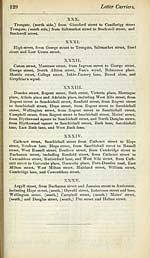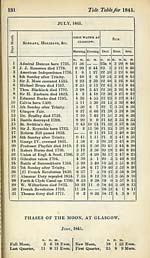Download files
Complete book:
Individual page:
Thumbnail gallery: Grid view | List view

Tide Table. 130
ALMANAC AND TIDE TABLE.
The flowing and ebbing of the sea, one of the most remarkable pheno-
mena in nature, is caused by the attraction of the sun and moon on the
waters of the ocean. Each of these luminaries produces an elevation of
the waters, which astronomers distinguish by the names of the Solar and
Lunar Tides respectively. The Lunar is greater than the Solar Tide,
in the proportion of three to one nearly.
At new and full moon the influence of these bodies conspire, and the
sum of the two tides is called a Spring Tide ; but when the moon is in
the quadratures, the bodies then acting at right angles to each other, the
high water produced is the difference between the Lunar and Solar Tide,
and is called a Neap Tide.
Although at places situated near the ocean the coincidence between
the computed and observed time of high water is exceedingly near, yet
at inland situations, to which the waters flow, as it were, indirectly, the
irregularities, both as to time and elevation, are very considerable.
T\\& great tide wave, flowing from the Atlantic Ocean to the British
Isles, on arriving at the South coast, divides itself into three branches,
one of which flows up the English channel, another enters St. George's
channel South, the third flows round the West and North coasts of
Ireland, and enters St. George's channel North, where it meets with the
second branch from which it parted some hours before. The tide that
flows up the Clyde is derived from these two branches combined, and it
is easy to conceive how it must partake of all the irregularities produced
on them by the action of high winds ; and hence the reason of the ano-
malies that some times are observed, when no apparent cause is operating
in the Clyde itself. High winds in the Clyde likewise affect the time
and elevation of high water ; and by considering the form and course of
the Frith, it will be readily understood why a gale from a northerly
direction, by opposing the flow of the tide, will cause the time of high
water to be earlier, and the height of the tide to be less, than otherwise
would be the case. While a gale from a southerly direction, acting in
concert with the flowing tide, will produce a contrary effect.
In the following Table are included the watering places on our coast,
which, on account of their proximity, are chiefly interesting to the
inhabitants of Glasgow as places of summer visiting or retreat. It
exhibits the number of hours and minutes that the time of high water, a5
the respective places, is sooner than the time shown by the Glasgow Tide
Table.
H. M.
H. M.
Ardrossan, ,.>....„»,„
......soonei
1 50
1 45
Helensburgh, „.«.
Innerkip, .^^^.^^^
..M~~.sooner 1 30
Ascog, ™~ ~-» —
1 35
Ayr, ~~
«..~v^
I 55
Irvine,~w.
I 50
Brodick Bay, ~~..
1 50
Lamlash,
— 1 50
Campbeltown,
™. —
2 10
Largs,
1 40
Cantyre Mull,.„™
.-™~™, —
2 20
Loch Ryan,
— 2 20
Dublin,
,w»™.,.
3
Millport,
— 1 45
Dumbarton,
^,„„^
1 10
Rothesay,~-~
— 1 40
Dunoon,
•^-.^^^
I 30
Saltcoats,
— 1 45
Greenock, ,„.~~»^~.
».^««.«
1 30
Troon....... ,.~.
1 45
Gourock,
, —
I 30
^^'''^oV/^ Warehouse,) DAVID HERON.
21», Broomielaw. i
ALMANAC AND TIDE TABLE.
The flowing and ebbing of the sea, one of the most remarkable pheno-
mena in nature, is caused by the attraction of the sun and moon on the
waters of the ocean. Each of these luminaries produces an elevation of
the waters, which astronomers distinguish by the names of the Solar and
Lunar Tides respectively. The Lunar is greater than the Solar Tide,
in the proportion of three to one nearly.
At new and full moon the influence of these bodies conspire, and the
sum of the two tides is called a Spring Tide ; but when the moon is in
the quadratures, the bodies then acting at right angles to each other, the
high water produced is the difference between the Lunar and Solar Tide,
and is called a Neap Tide.
Although at places situated near the ocean the coincidence between
the computed and observed time of high water is exceedingly near, yet
at inland situations, to which the waters flow, as it were, indirectly, the
irregularities, both as to time and elevation, are very considerable.
T\\& great tide wave, flowing from the Atlantic Ocean to the British
Isles, on arriving at the South coast, divides itself into three branches,
one of which flows up the English channel, another enters St. George's
channel South, the third flows round the West and North coasts of
Ireland, and enters St. George's channel North, where it meets with the
second branch from which it parted some hours before. The tide that
flows up the Clyde is derived from these two branches combined, and it
is easy to conceive how it must partake of all the irregularities produced
on them by the action of high winds ; and hence the reason of the ano-
malies that some times are observed, when no apparent cause is operating
in the Clyde itself. High winds in the Clyde likewise affect the time
and elevation of high water ; and by considering the form and course of
the Frith, it will be readily understood why a gale from a northerly
direction, by opposing the flow of the tide, will cause the time of high
water to be earlier, and the height of the tide to be less, than otherwise
would be the case. While a gale from a southerly direction, acting in
concert with the flowing tide, will produce a contrary effect.
In the following Table are included the watering places on our coast,
which, on account of their proximity, are chiefly interesting to the
inhabitants of Glasgow as places of summer visiting or retreat. It
exhibits the number of hours and minutes that the time of high water, a5
the respective places, is sooner than the time shown by the Glasgow Tide
Table.
H. M.
H. M.
Ardrossan, ,.>....„»,„
......soonei
1 50
1 45
Helensburgh, „.«.
Innerkip, .^^^.^^^
..M~~.sooner 1 30
Ascog, ™~ ~-» —
1 35
Ayr, ~~
«..~v^
I 55
Irvine,~w.
I 50
Brodick Bay, ~~..
1 50
Lamlash,
— 1 50
Campbeltown,
™. —
2 10
Largs,
1 40
Cantyre Mull,.„™
.-™~™, —
2 20
Loch Ryan,
— 2 20
Dublin,
,w»™.,.
3
Millport,
— 1 45
Dumbarton,
^,„„^
1 10
Rothesay,~-~
— 1 40
Dunoon,
•^-.^^^
I 30
Saltcoats,
— 1 45
Greenock, ,„.~~»^~.
».^««.«
1 30
Troon....... ,.~.
1 45
Gourock,
, —
I 30
^^'''^oV/^ Warehouse,) DAVID HERON.
21», Broomielaw. i
Set display mode to: Large image | Transcription
Images and transcriptions on this page, including medium image downloads, may be used under the Creative Commons Attribution 4.0 International Licence unless otherwise stated. ![]()
| Scottish Post Office Directories > Towns > Glasgow > Post-Office annual Glasgow directory > 1841-1842 > (534) |
|---|
| Permanent URL | https://digital.nls.uk/83831956 |
|---|
| Description | Directories of individual Scottish towns and their suburbs. |
|---|
| Description | Around 700 Scottish directories published annually by the Post Office or private publishers between 1773 and 1911. Most of Scotland covered, with a focus on Edinburgh, Glasgow, Dundee and Aberdeen. Most volumes include a general directory (A-Z by surname), street directory (A-Z by street) and trade directory (A-Z by trade). |
|---|


